Assessing the Influence of Compounding Factors to the Water Level Variation of Erhai Lake
Abstract
:1. Introduction
2. Materials and Methods
2.1. Study Area
2.2. Data Sources
2.3. Methodology
2.3.1. Mann-Kendall Method
2.3.2. Hurst Exponent
2.3.3. PCA
- (1)
- Determine the principal component model, as defined by Equation (5):where F1, F2, ..., Fm are the m principal components obtained after the analysis, uij is the coefficient in the decision matrix when SPSS software is used for the principal component analysis, and the initial factor load fij is not the coefficient uij of the decision matrix. The relationship between fij and uij is shown in Equation (6):where fij is the initial factor load, is principal component eigenvalues; and uij is decision matrix coefficient.
- (2)
- Construct the comprehensive evaluation function, as defined by the following formula Equation (7):where a1, a2,…, aL is the index w1, w2, …, showing the comprehensive importance of wL in the principal component, and k is the sum of the eigenvalues.
- (3)
- Calculate the weight of each indicator by Equation (8):
3. Results
3.1. Variation in Precipitation and Inflow and Outflow in the Erhai Lake Basin
3.1.1. Variation in Precipitation in the Erhai Lake Basin
3.1.2. Variation in the Inflow and Outflow of Erhai Lake
3.1.3. Variation in the Erhai Lake Water Balance
3.2. Characteristics of Water Level Variation in EL
3.2.1. Interannual Variation Trend and Stage Characteristics of Water Level in EL
3.2.2. Seasonal Characteristics and Trend of Water Level Variation in Erhai Lake
4. Discussion
4.1. Influence Factors and Ecological Effects of Water Level Change in EL
4.2. Quantitating the Contribution of Compounding Influencing Factors to Water Level Change
5. Conclusions
- (1)
- Over the past 30 years, the total volume of EL has been in a state of dynamic positive balance. In 1990–2004, it was mainly influenced by the increase in water consumption, and the volume of EL was in a negative balanced state. In 2005–2019, it was mainly influenced by the adjustment of the operating water level of EL and the connected water replenishment project of the three reservoirs: the outflow decreased, the lake water storage increased, and the volume of EL was in a positive balanced state. Although the water volume in 2005–2019 was in a positive balance, due to the increase in evaporation and the decrease in inflow, the water volume in 2013–2019 was in a negative balance.
- (2)
- In 1990–2019, the water level of EL rose at a rate of 47 mm/a. In 1990–2004 (before the mutation), with population growth and social and economic development, the development and utilization intensity of EL water resources increased, coupled with a decrease in water inflow, which resulted in a decrease in the WL. In 2005–2019 (after the mutation), the evaporation and outflow decreased by 8% and 52% compared with that in 1990–2004, respectively, and the water consumption of the lake decreased. Together with the increased water replenishment, this led to an upward trend of the water level, which was 0.81 m higher than that in 1990–2004. However, affected by the decrease in precipitation and the increase in evaporation and the interception of inflow by the sewage interception project, the decrease in the WL in 2013–2019 slowed the rising trend of the WL in EL in 2005–2019. It has been predicted that the WL will decrease in the future (H = 0.048 < 0.5), which was mainly related to the increase in future lake discharge (H = 0.046) and evaporation (H = 0.048). In addition, it was predicted that the future WL will show a downward trend (H = 0.048 < 0.5), which is mainly affected by the increase in outflow (H = 0.042) and evaporation (H = 0.048) in the future.
- (3)
- In 1990–2019, the decrease in outflow was the major factor influencing the WL change in EL, with a contribution of 19.34%. In 1990–2004, the WL change was mainly caused by the large outflow, with a contribution of 21.61%. In 2005–2019, the change in cultivated area was the main factor influencing the WL fluctuation of EL, with a contribution of 20.48%. In the future, with the impact of climate change and human activities, the precipitation may with increased probability decrease (H = 0.049 < 0.5) and the inflow intercepted by the pollution interception project will have an important impact on the fluctuation of the WL. In particular, in 2013–2019, the maximum contribution of climate change to WL changes was 40.35%. Therefore, the protection and management of EL should consider the demand of WL management when paying attention to reducing the pollution load into the lake and improving the water quality of the lake. Moreover, lake managers should pay more attention to the impact of human activities on the water level, such as wastewater interception and treatment projects around the lake, and also focus on the impact of climate change, which is very important for WL management and EL protection and treatment.
Supplementary Materials
Author Contributions
Funding
Institutional Review Board Statement
Informed Consent Statement
Data Availability Statement
Acknowledgments
Conflicts of Interest
References
- Geng, M.; Wang, K.; Yang, N.; Li, F.; Zou, Y.; Chen, X.; Deng, Z.; Xie, Y. Evaluation and variation trends analysis of water quality in response to water regime changes in a typical river-connected lake (dongting lake), china. Environ. Pollut. 2020, 268, 115761. [Google Scholar] [CrossRef] [PubMed]
- Alamanos, A.; Latinopoulos, D.; Papaioannou, G.; Mylopoulos, N. Integrated hydro-economic modeling for sustainable water resources management in data-scarce areas: The case of lake karla watershed in greece. Water Resour. Manag. 2019, 33, 2775–2790. [Google Scholar] [CrossRef]
- Kuil, L.; Carr, G.; Viglione, A.; Prskawetz, A.; Bloeschl, G. Conceptualizing socio-hydrological drought processes: The case of the maya collapse. Water Resour. Res. 2016, 52, 6222–6242. [Google Scholar] [CrossRef] [PubMed] [Green Version]
- Zhang, G.; Xie, H.; Yao, T.; Kang, S. Water balance estimates of ten greatest lakes in china using icesat and landsat data. Chin. Sci. Bull. 2013, 58, 3815–3829. [Google Scholar] [CrossRef] [Green Version]
- Huntington, T.G. Evidence for intensification of the global water cycle: Review and synthesis. J. Hydrol. 2006, 319, 83–95. [Google Scholar] [CrossRef]
- Adrian, R.; O’Reilly, C.M.; Zagarese, H.; Baines, S.B.; Hessen, D.O.; Keller, W.; Livingstone, D.M.; Sommaruga, R.; Straile, D.; Van Donk, E.; et al. Lakes as sentinels of climate change. Limnol. Oceanogr. 2009, 54, 2283–2297. [Google Scholar] [CrossRef]
- Cardille, J.A.; Carpenter, S.R.; Foley, J.A.; Hanson, P.C.; Turner, M.G.; Vano, J.A. Climate change and lakes: Estimating sensitivities of water and carbon budgets. J. Geophys. Res. Biogeo 2009, 114. [Google Scholar] [CrossRef] [Green Version]
- Panagoulia, D. Impacts of giss-modelled climate changes on catchment hydrology. Hydrol. Sci. J. 1992, 37, 141–163. [Google Scholar] [CrossRef]
- Panagoulia, D. hydrological response of a medium-sized mountainous catchment to climate changes. Hydrol. Sci. J. 1991, 36, 525–547. [Google Scholar] [CrossRef]
- Shankman, D.; Keim, B.D.; Song, J. Flood frequency in china’s poyang lake region: Trends and teleconnections. Int. J. Climatol. 2006, 26, 1255–1266. [Google Scholar] [CrossRef] [Green Version]
- Chen, H.; Song, S.; Lee, T.; Lowemark, L.; Chi, Z.; Wang, Y.; Hong, E. A multiproxy lake record from inner mongolia displays a late holocene teleconnection between central asian and north atlantic climates. Quat. Int. 2010, 227, 170–182. [Google Scholar] [CrossRef]
- Gao, Y.; Xie, Y.; Zou, D. Hydrological regime change and its ecological responses in east dongting lake, china. Ecohydrol. Hydrobiol. 2020, 20, 142–150. [Google Scholar] [CrossRef]
- Zohary, T.; Ostrovsky, I. Ecological impacts of excessive water level fluctuations in stratified freshwater lakes. Inland Waters 2011, 1, 47–59. [Google Scholar] [CrossRef]
- Song, M.; Wang, R.; Zeng, X. Water resources utilization efficiency and influence factors under environmental restrictions. J. Clean. Prod. 2018, 184, 611–621. [Google Scholar] [CrossRef]
- Poff, N.L.; Allan, J.D.; Bain, M.B.; Karr, J.R.; Prestegaard, K.L.; Richter, B.D.; Sparks, R.E.; Stromberg, J.C. The natural flow regime. Bioscience 1997, 47, 769–784. [Google Scholar] [CrossRef]
- Zhou, J.; Zhang, M. Eco-problem of poyang lake in yangtze river and effect of sluice gate construction at lake's outlet. Water Resour. Prot. 2019, 35, 1–12. [Google Scholar]
- Xu, R.; Pang, Y.; Hu, Z.; Zhu, T. Influence study about water exchange on the taihu lake based on the water diversion project from the yangtze river to the taihu lake (wdyt). China Environ. Sci. 2020, 40, 375–382. [Google Scholar]
- Huang, Y.; Yu, M.; Lu, J.; Sun, Z.; Tian, H. Suitable ecological water level of the east lake dongting after the three gorges project operation. J. Lake Sci. 2020, 32, 417–427. [Google Scholar]
- Li, D.; Ye, B.; Hou, Z.; Chu, Z.; Zheng, B. Long-term performance and microbial distribution of a filed-scale storing multi-pond constructed wetland with ottelia acuminata for the treatment of non-point source pollution. J. Clean. Prod. 2020, 262, 121367. [Google Scholar] [CrossRef]
- Jalili, S.; Hamidi, S.A.; Ghanbari, R.N. Climate variability and anthropogenic effects on lake urmia water level fluctuations, northwestern iran. Hydrol. Sci. J. 2016, 61, 1759–1769. [Google Scholar] [CrossRef] [Green Version]
- Deus, D.; Gloaguen, R.; Krause, P. Water balance modeling in a semi-arid environment with limited in situ data using remote sensing in lake manyara, east african rift, tanzania. Remote Sens. 2013, 5, 1651–1680. [Google Scholar] [CrossRef] [Green Version]
- Gronewold, A.D.; Rood, R.B. Recent water level changes across earth's largest lake system and implications for future variability. J. Gt. Lakes Res. 2019, 45, 1–3. [Google Scholar] [CrossRef]
- Alifujiang, Y.; Abuduwaili, J.; Ma, L.; Samat, A.; Groll, M. System dynamics modeling of water level variations of lake issyk-kul, kyrgyzstan. Water 2017, 9, 989. [Google Scholar] [CrossRef] [Green Version]
- Xiao, K.; Griffis, T.J.; Baker, J.M.; Bolstad, P.V.; Erickson, M.D.; Lee, X.; Wood, J.D.; Hu, C.; Nieber, J.L. Evaporation from a temperate closed-basin lake and its impact on present, past, and future water level. J. Hydrol. 2018, 561, 59–75. [Google Scholar] [CrossRef]
- Vicuna, S.; Dracup, J.A. The evolution of climate change impact studies on hydrology and water resources in california. Clim. Change 2007, 82, 327–350. [Google Scholar] [CrossRef]
- Senent-Aparicio, J.; Lopez-Ballesteros, A.; Perez-Sanchez, J.; Jose Segura-Mendez, F.; Pulido-Velazquez, D. Using multiple monthly water balance models to evaluate gridded precipitation products over peninsular spain. Remote Sens. 2018, 10, 922. [Google Scholar] [CrossRef] [Green Version]
- Pulido-Velazquez, D.; Renau-Prunonosa, A.; Llopis-Albert, C.; Morell, I.; Collados-Lara, A.; Senent-Aparicio, J.; Baena-Ruiz, L. Integrated assessment of future potential global change scenarios and their hydrological impacts in coastal aquifers—A new tool to analyse management alternatives in the plana oropesa-torreblanca aquifer. Hydrol. Earth Syst. Sci. 2018, 22, 3053–3074. [Google Scholar] [CrossRef] [Green Version]
- Collados-Lara, A.; Pulido-Velazquez, D.; Pardo-Iguzquiza, E. An integrated statistical method to generate potential future climate scenarios to analyse droughts. Water 2018, 10, 1224. [Google Scholar] [CrossRef] [Green Version]
- Gudmundsson, L.; Bremnes, J.B.; Haugen, J.E.; Engen-Skaugen, T. Technical note: Downscaling rcm precipitation to the station scale using statistical transformations—A comparison of methods. Hydrol. Earth Syst. Sci. 2012, 16, 3383–3390. [Google Scholar] [CrossRef] [Green Version]
- Hellstrom, C.; Chen, D.L.; Achberger, C.; Raisanen, J. Comparison of climate change scenarios for sweden based on statistical and dynamical downscaling of monthly precipitation. Clim. Res. 2001, 19, 45–55. [Google Scholar] [CrossRef]
- Yan, C.; Lu, X.; Zhao, X. Protection and sustainable utilisation of water resources in lake erhai basin. Int. J. Sustain. Dev. World 2008, 15, 357–361. [Google Scholar] [CrossRef]
- Wu, A.; Zhao, Y.; Qi, L.; Zhu, G.; Chen, F.; Liang, Y.; Cao, T.; Zhong, W. Faster response to water level increase facilitates salix cavaleriei survival in lake erhai. J. Freshw. Ecol. 2019, 34, 469–480. [Google Scholar] [CrossRef] [Green Version]
- Ni, Z.; Wang, S.; Zhao, H.; Jiao, L.; Jin, X. The sources of organic carbon and nitrogen of suspended particulate matter in inflow river of erhai lake. Res. Environ. Sci. 2013, 26, 287–293. [Google Scholar]
- Wang, S.; Zhang, L.; Ni, L.; Zhao, H.; Jiao, L.; Yang, S.; Guo, L.; Shen, J. Ecological degeneration of the erhai lake and prevention measures. Environ. Earth Sci. 2015, 74, 3839–3847. [Google Scholar] [CrossRef]
- Ni, Z.; Wang, S.; Zhang, M. Sediment amino acids as indicators of anthropogenic activities and potential environmental risk in erhai lake, southwest china. Sci. Total Environ. 2016, 551, 217–227. [Google Scholar] [CrossRef]
- Ye, X.; Liu, F.; Zhang, Z.; Xu, C. Quantifying the impact of compounding influencing factors to the water level decline of china's largest freshwater lake. J. Water Res. Plan. Man. 2020, 146, 05020006. [Google Scholar] [CrossRef]
- Wang, D.; Hejazi, M. Quantifying the relative contribution of the climate and direct human impacts on mean annual streamflow in the contiguous united states. Water Resour. Res. 2011, 47. [Google Scholar] [CrossRef] [Green Version]
- Ye, B.; Chu, Z.; Wu, A.; Hou, Z.; Wang, S. Optimum water depth ranges of dominant submersed macrophytes in a natural freshwater lake. PLoS ONE 2018, 13, e0193176. [Google Scholar] [CrossRef] [Green Version]
- Mann, H.B. Nonparametric tests against trend. Econometrica 1945, 13, 245–259. [Google Scholar] [CrossRef]
- Hamed, K.H. Exact distribution of the mann-kendall trend test statistic for persistent data. J. Hydrol. 2009, 365, 86–94. [Google Scholar] [CrossRef]
- Gan, T.Y. Hydroclimatic trends and possible climatic warming in the canadian prairies. Water Resour. Res. 1998, 34, 3009–3015. [Google Scholar] [CrossRef]
- Liu, C.M.; Zheng, H.X. Changes in components of the hydrological cycle in the yellow river basin during the second half of the 20th century. Hydrol. Process. 2004, 18, 2337–2345. [Google Scholar] [CrossRef]
- Liu, J.; Fang, S.; Feng, Q.; Wu, Z.; Han, L.; Huang, J.; Bai, X. Analysis of regime shift in taihu lake based on mann-kendall method. China Environ. Sci. 2015, 35, 3707–3713. [Google Scholar]
- Stan, C.; Marmureanu, L.; Marin, C.; Cristescu, C.P. Investigation of multifractal cross-correlation surfaces of hurst exponents for some atmospheric pollutants. Phys. A 2020, 545, 123799. [Google Scholar] [CrossRef]
- Ying, H.; Zhang, H.; Zhao, J.; Shan, Y.; Zhang, Z.; Guo, X.; Wu, R.; Deng, G. Effects of spring and summer extreme climate events on the autumn phenology of different vegetation types of inner mongolia, china, from 1982 to 2015. Ecol. Indic. 2020, 111, 105974. [Google Scholar] [CrossRef]
- Xu, W.; Liang, Y.; Cushman, J.H.; Chen, W. Ultrafast dynamics modeling via fractional brownian motion run with mittag-leffler clock in porous media. Int. J. Heat Mass Tran. 2020, 151, 119402. [Google Scholar] [CrossRef]
- Bu, Q.; Bi, J.; Yuan, Z.; Huang, L. R/s method for evaluation of pollutant time series in environmental quality assessment. Water Sci. Eng. 2008, 1, 82–88. [Google Scholar]
- Ren, L.; Song, C.; Wu, W.; Guo, M.; Zhou, X. Reservoir effects on the variations of the water temperature in the upper yellow river, china, using principal component analysis. J. Environ. Manag. 2020, 262, 110339. [Google Scholar] [CrossRef]
- He, K.; Gao, W.; Duan, C.; Zhu, Y.; Pan, Y.; Liu, C.; Zhang, W.; Yang, G. Water level variation and its driving factors in lake dianchi, fuxian and yangzong during 1988–2015. J. Lake Sci. 2019, 31, 1379–1390. [Google Scholar]
- Hill, N.M.; Keddy, P.A.; Wisheu, I.C. A hydrological model for predicting the effects of dams on the shoreline vegetation of lakes and reservoirs. Environ. Manag. 1998, 22, 723–736. [Google Scholar] [CrossRef]
- Riis, T.; Hawes, I. Relationships between water level fluctuations and vegetation diversity in shallow water of new zealand lakes. Aquat. Bot. 2002, 74, 133–148. [Google Scholar] [CrossRef]
- White, M.S.; Xenopoulos, M.A.; Hogsden, K.; Metcalfe, R.A.; Dillon, P.J. Natural lake level fluctuation and associated concordance with water quality and aquatic communities within small lakes of the laurentian great lakes region. Hydrobiologia 2008, 613, 21–31. [Google Scholar] [CrossRef]
- Fu, H.; Yuan, G.; Cao, T.; Zhong, J.; Zhang, X.; Guo, L.; Zhang, M.; Ni, L.; Wang, S. Succession of submerged macrophyte communities in relation to environmental change in lake erhai over the past 50 years. J. Lake Sci. 2013, 25, 854–861. [Google Scholar]
- Carmignani, J.R.; Roy, A.H. Ecological impacts of winter water level drawdowns on lake littoral zones: A review. Aquat. Sci. 2017, 79, 803–824. [Google Scholar] [CrossRef] [Green Version]
- Stendera, S.; Adrian, R.; Bonada, N.; Canedo-Argueelles, M.; Hugueny, B.; Januschke, K.; Pletterbauer, F.; Hering, D. Drivers and stressors of freshwater biodiversity patterns across different ecosystems and scales: A review. Hydrobiologia 2012, 696, 1–28. [Google Scholar] [CrossRef]
- Strayer, D.L.; Findlay, S.E.G. Ecology of freshwater shore zones. Aquat. Sci. 2010, 72, 127–163. [Google Scholar] [CrossRef] [Green Version]
- Winfield, I.J. Fish in the littoral zone: Ecology, threats and management. Limnologica 2004, 34, 124–131. [Google Scholar] [CrossRef] [Green Version]
- Vilhena, L.C.; Hillmer, I.; Imberger, J. The role of climate change in the occurrence of algal blooms: Lake burragorang, australia. Limnol. Oceanogr. 2010, 55, 1188–1200. [Google Scholar] [CrossRef]
- Bhele, U.; Öğlü, B.; Tuvikene, A.; Bernotas, P.; Silm, M.; Järvalt, A.; Agasild, H.; Zingel, P.; Seller, S.; Timm, H.; et al. How long-term water level changes influence the spatial distribution of fish and other functional groups in a large shallow lake. J. Great Lakes Res. 2020, 46, 813–823. [Google Scholar] [CrossRef]
- Zhang, S.; Wang, R.; Shen, J.; Ma, C.; Xiao, W. Potential relationship of wintering waterbirds community composition and water-level fluctuation in lake erhai. Asian J. Ecotoxicol. 2018, 13, 143–148. [Google Scholar]
- Chen, X.; Qian, X.; Li, X.; Wei, Z.; Hu, S. Long-term trend of eutrophication state of lake erhai in 1988 -2013 and analyses of its socio-economic drivers. J. Lake Sci. 2018, 30, 70–78. [Google Scholar]
- Lin, S.; Shen, S.; Zhou, A.; Lyu, H. Sustainable development and environmental restoration in lake erhai, china. J. Clean. Prod. 2020, 258, 120758. [Google Scholar] [CrossRef]
- Song, S.; Xu, Y.P.; Wu, Z.F.; Deng, X.J.; Wang, Q. The relative impact of urbanization and precipitation on long-term water level variations in the yangtze river delta. Sci. Total Environ. 2019, 648, 460–471. [Google Scholar] [CrossRef] [PubMed]
- Yin, X.A.; Yang, Z.F. A method to assess the alteration of water-level-fluctuation patterns in lakes. Procedia Environ. Sci. 2012, 13, 2427–2436. [Google Scholar] [CrossRef] [Green Version]
- Coops, H.; Hosper, S.H. Water-level management as a tool for the restoration of shallow lakes in the netherlands. Lake Reserv. Manag. 2002, 18, 293–298. [Google Scholar] [CrossRef] [Green Version]
- Johnson, N.; Revenga, C.; Echeverria, J. Ecology—Managing water for people and nature. Science 2001, 292, 1071–1072. [Google Scholar] [CrossRef]
- Tang, C.; Yi, Y.; Yang, Z.; Zhang, S.; Liu, H. Effects of ecological flow release patterns on water quality and ecological restoration of a large shallow lake. J. Clean. Prod. 2018, 174, 577–590. [Google Scholar] [CrossRef]
- Meador, M.R. Inter-basin water transfer: Ecological concerns. Fisheries 1992, 17, 17–22. [Google Scholar] [CrossRef]
- Cramer, W.; Guiot, J.; Fader, M.; Garrabou, J.; Gattuso, J.; Iglesias, A.; Lange, M.A.; Lionello, P.; Carmen Llasat, M.; Paz, S.; et al. Climate change and interconnected risks to sustainable development in the mediterranean. Nat. Clim. Change 2018, 8, 972–980. [Google Scholar] [CrossRef] [Green Version]
- Tramblay, Y.; Koutroulis, A.; Samaniego, L.; Vicente-Serrano, S.M.; Volaire, F.; Boone, A.; Le Page, M.; Carmen Llasat, M.; Albergel, C.; Burak, S.; et al. Challenges for drought assessment in the mediterranean region under future climate scenarios. Earth Sci. Rev. 2020, 210, 103348. [Google Scholar] [CrossRef]
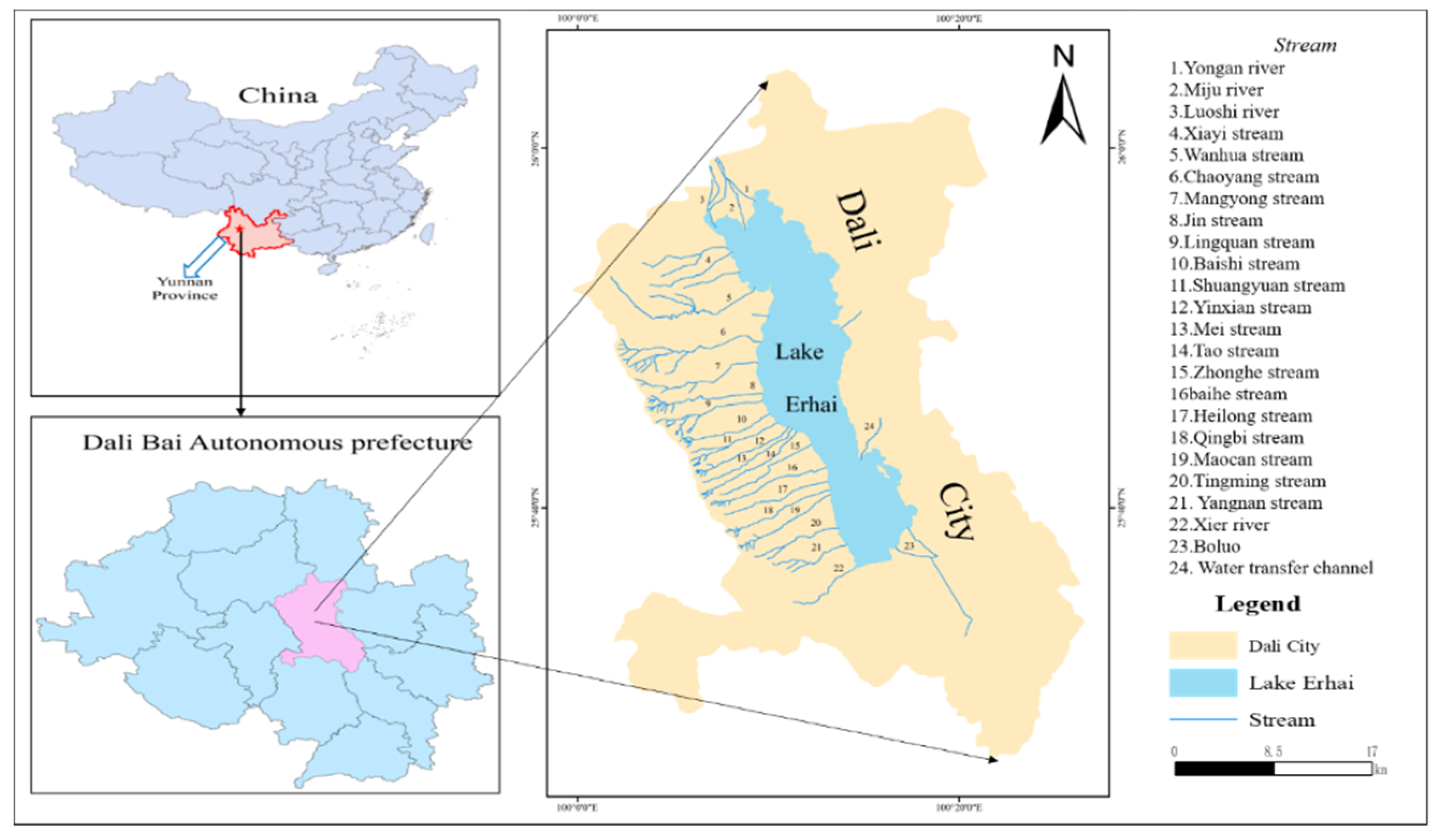
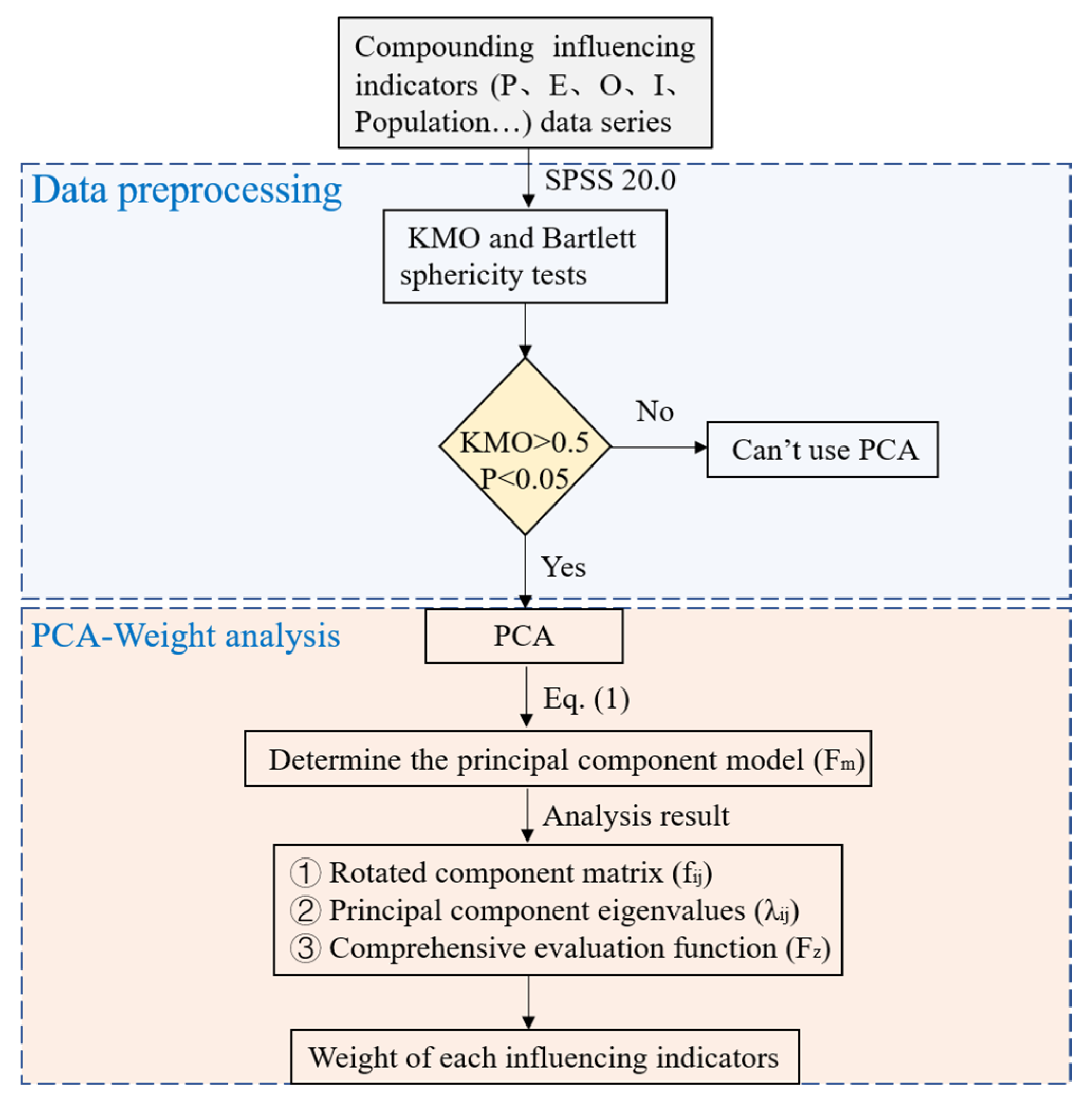
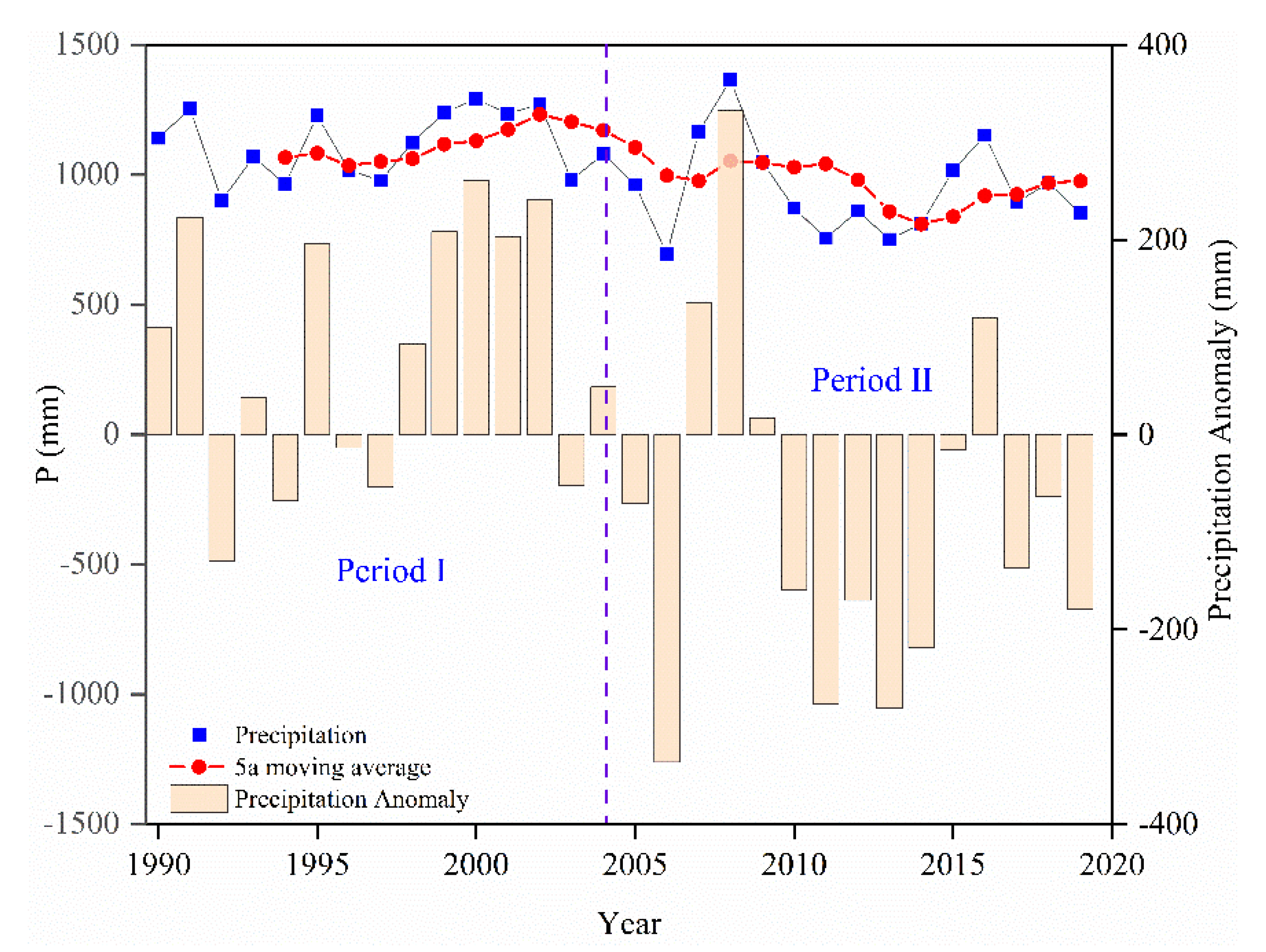
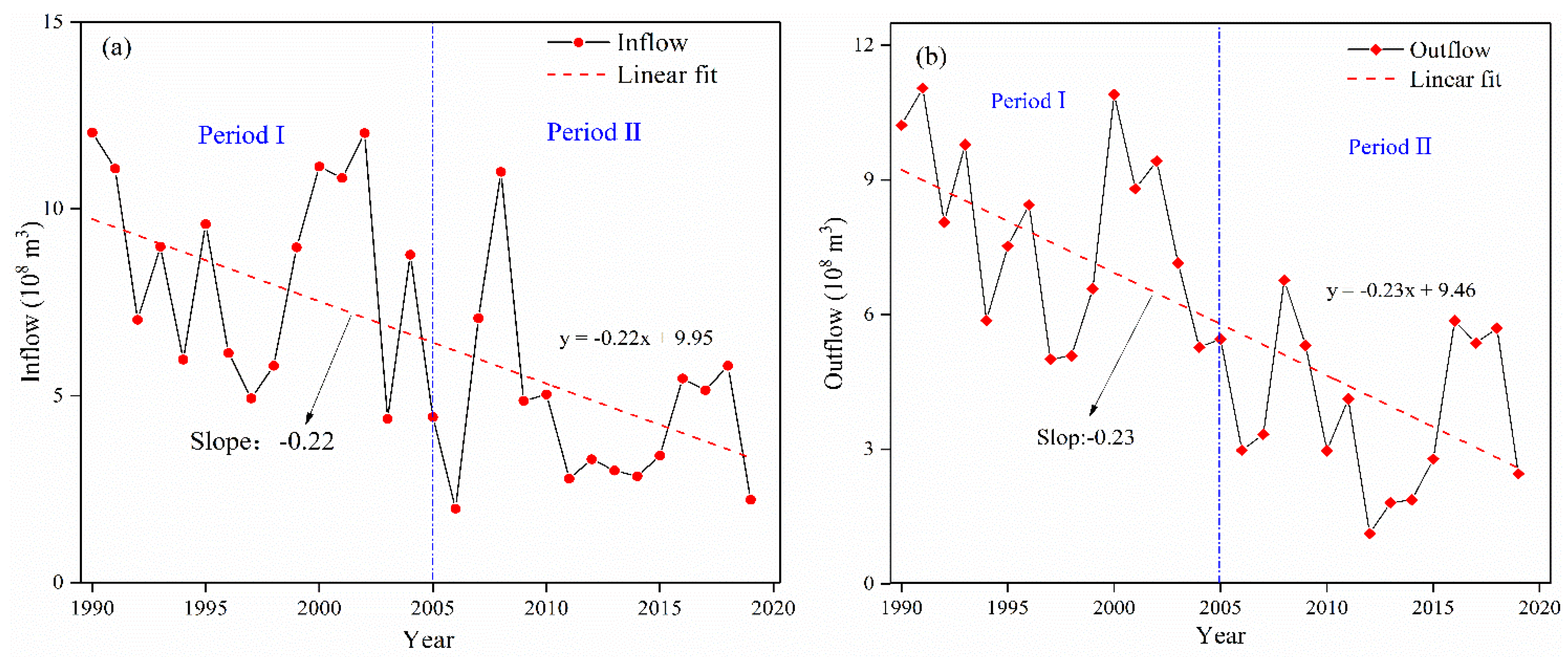
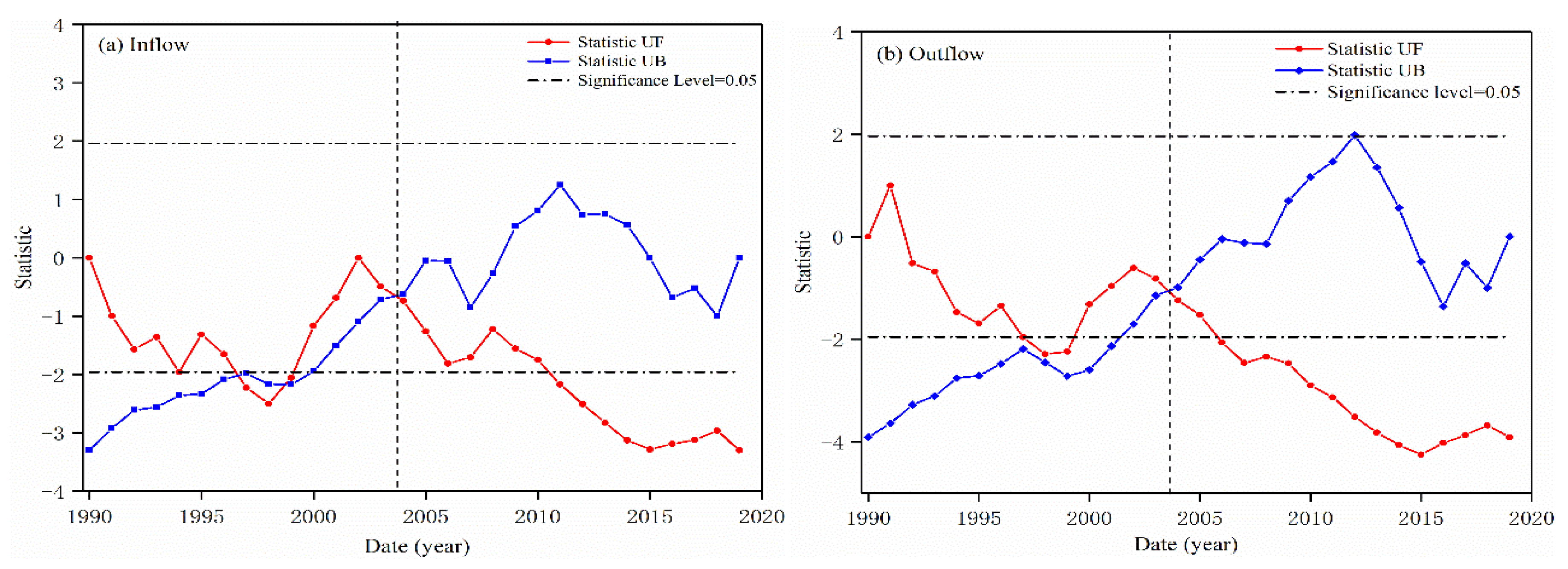
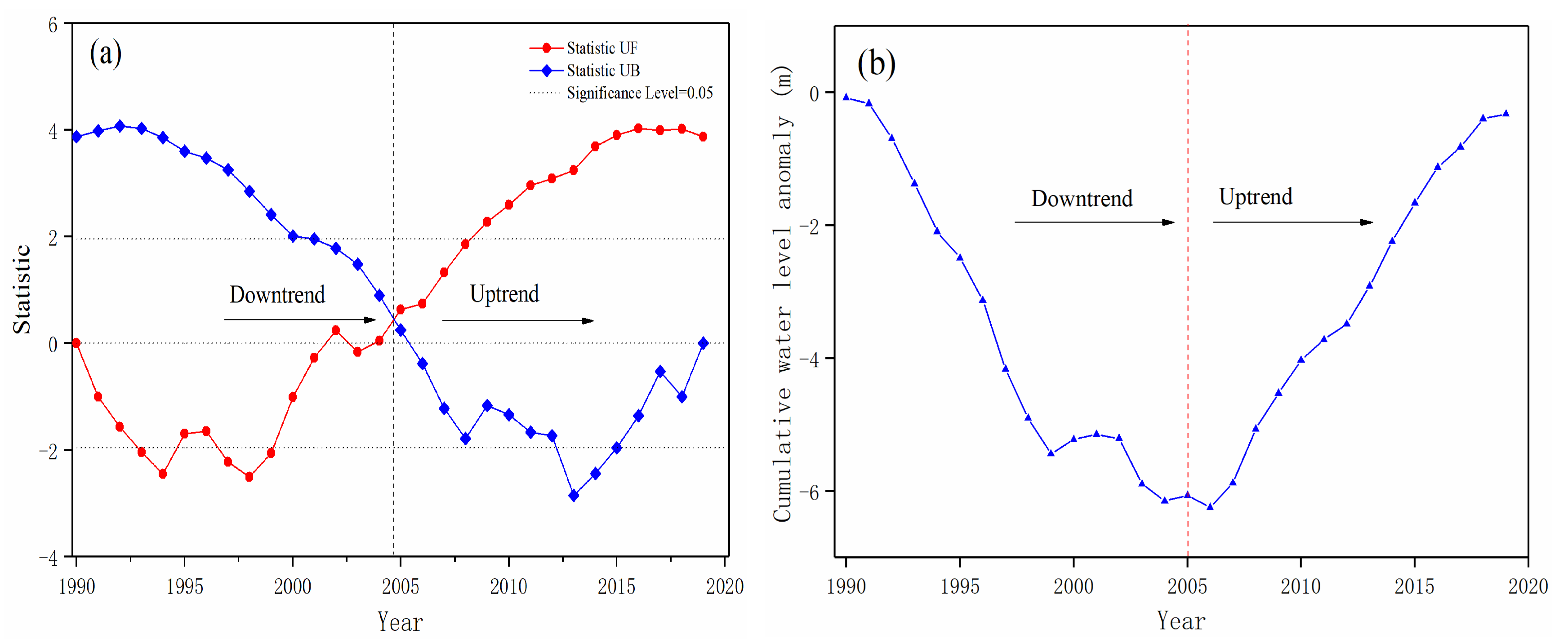
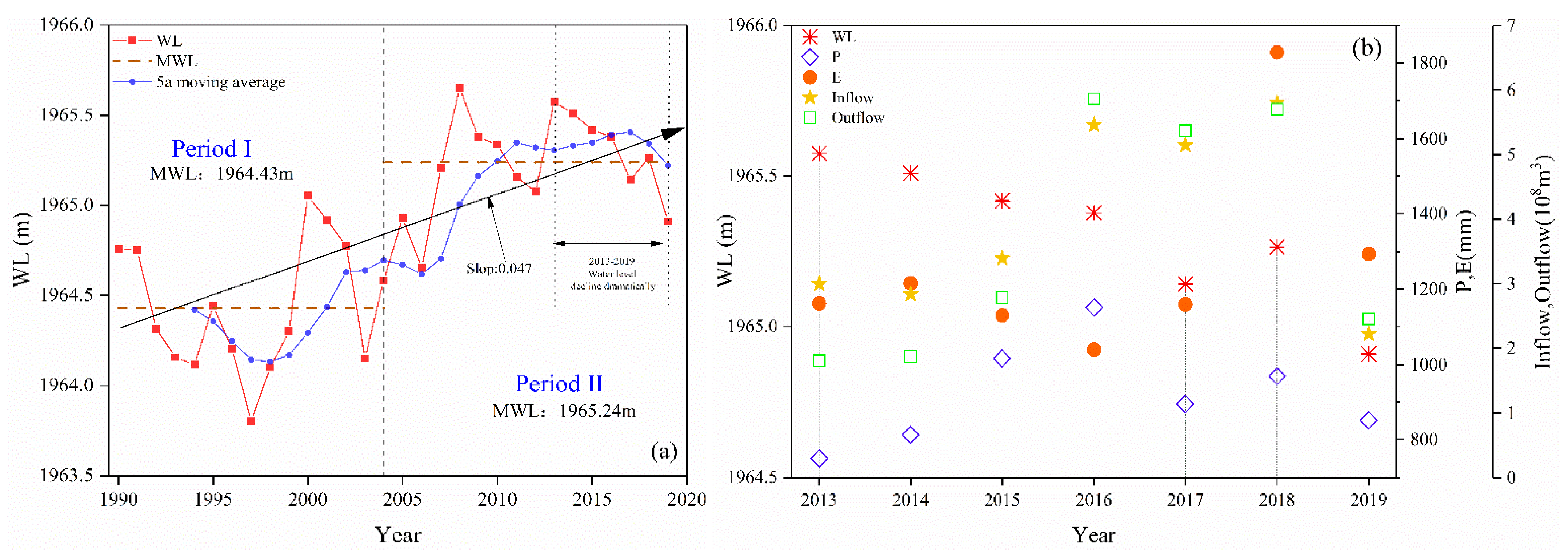
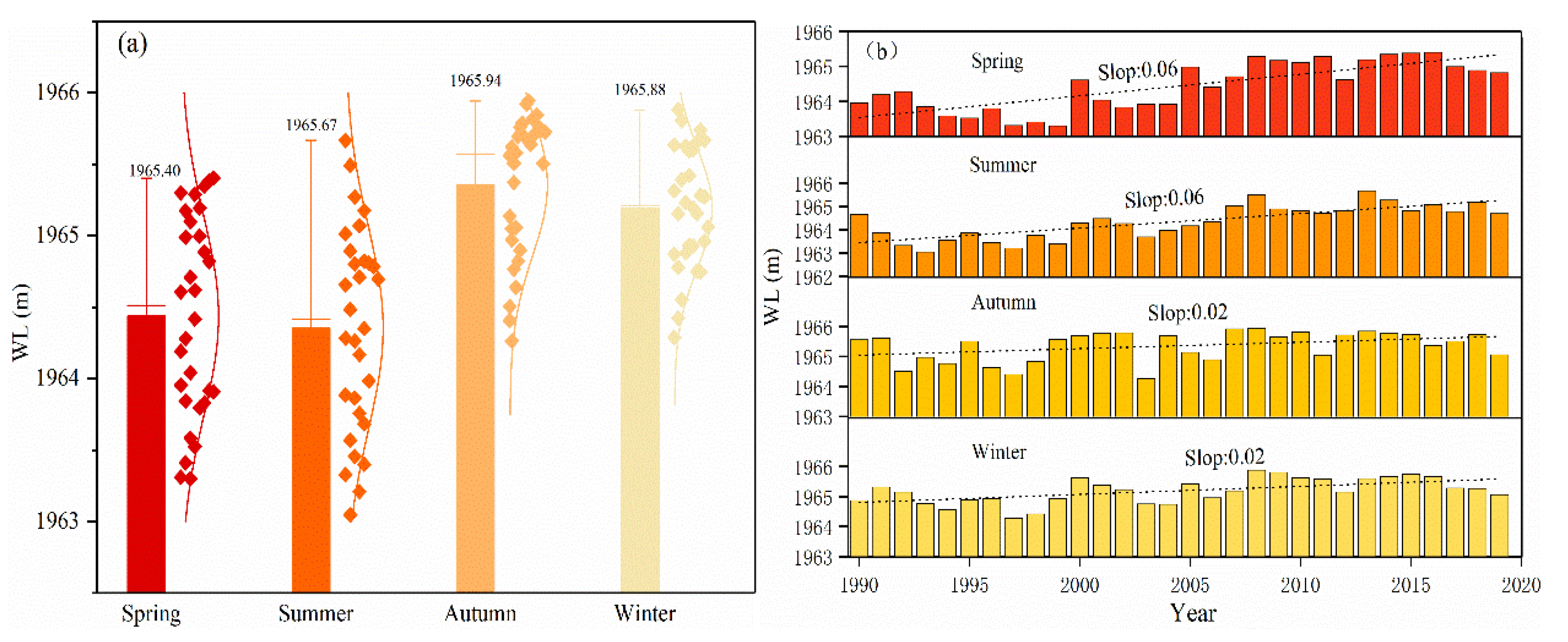

| Category | Variable | Series Length | Data sources |
|---|---|---|---|
| Water level data | Water level | 1990–2019 | Erhai Conservation Administration |
| Water volume data | Outflow Inflow Water transfer | 1990–2019 | Erhai Conservation Administration |
| Meteorological data | Precipitation Evaporation | 1990–2019 | http://www.escience.gov.cn |
| Social development data | Cultivated land area Basin population | 1990–2019 | Statistical Yearbook of Yunnan Province Statistical Yearbook of Dali Prefecture |
| Period | Precipitation (108 m3) | Evaporation (108 m3) | Inflow (108 m3) | Outflow (108m3) | Water Supplement Project (108 m3) | Storage Variation (108 m3) | |
|---|---|---|---|---|---|---|---|
| Xi’er River | Water Transfer Project | ||||||
| 1990–2004 | 2.83 | 3.31 | 8.51 | 7.55 | 0.54 | -- | −0.06 |
| 2005–2019 | 2.39 | 3.04 | 4.55 | 3.10 | 0.76 | 0.08 | 0.12 |
| 1990–2019 | 2.61 | 3.18 | 6.53 | 5.32 | 0.65 | 0.04 | 0.03 |
| Period | Index | Factor 1 | Factor2 | Comprehensive Score | Weight (%) |
|---|---|---|---|---|---|
| 1990–2004 | Inflow | 0.123 | 0.954 | 0.321 | 17.52% |
| Outflow | 0.483 | 0.759 | 0.399 | 21.61% | |
| Precipitation | −0.249 | 0.913 | 0.188 | 10.25% | |
| Evaporation | 0.922 | 0.080 | 0.324 | 17.68% | |
| Cultivated area | 0.888 | −0.003 | 0.289 | 15.74% | |
| Population | 0.950 | 0.071 | 0.331 | 18.03% | |
| 2005–2019 | Inflow | 0.937 | 0.150 | 0.370 | 20.12% |
| Outflow | 0.853 | −0.114 | 0.259 | 14.11% | |
| Precipitation | 0.914 | 0.120 | 0.352 | 19.18% | |
| Evaporation | −0.077 | 0.720 | 0.196 | 10.65% | |
| Cultivated area | 0.380 | 0.794 | 0.376 | 20.48% | |
| Population | −0.013 | 0.935 | 0.284 | 15.46% | |
| 1990–2019 | Inflow | 0.924 | 0.209 | 0.385 | 18.31% |
| Outflow | 0.816 | 0.430 | 0.406 | 19.34% | |
| Precipitation | 0.941 | −0.106 | 0.306 | 14.54% | |
| Evaporation | −0.039 | 0.868 | 0.221 | 10.54% | |
| Cultivated area | 0.689 | 0.546 | 0.393 | 18.69% | |
| Population | 0.533 | 0.743 | 0.391 | 18.59% |
Publisher’s Note: MDPI stays neutral with regard to jurisdictional claims in published maps and institutional affiliations. |
© 2020 by the authors. Licensee MDPI, Basel, Switzerland. This article is an open access article distributed under the terms and conditions of the Creative Commons Attribution (CC BY) license (http://creativecommons.org/licenses/by/4.0/).
Share and Cite
Wu, H.; Wang, S.; Wu, T.; Yao, B.; Ni, Z. Assessing the Influence of Compounding Factors to the Water Level Variation of Erhai Lake. Water 2021, 13, 29. https://doi.org/10.3390/w13010029
Wu H, Wang S, Wu T, Yao B, Ni Z. Assessing the Influence of Compounding Factors to the Water Level Variation of Erhai Lake. Water. 2021; 13(1):29. https://doi.org/10.3390/w13010029
Chicago/Turabian StyleWu, Huaxin, Shengrui Wang, Tao Wu, Bo Yao, and Zhaokui Ni. 2021. "Assessing the Influence of Compounding Factors to the Water Level Variation of Erhai Lake" Water 13, no. 1: 29. https://doi.org/10.3390/w13010029
APA StyleWu, H., Wang, S., Wu, T., Yao, B., & Ni, Z. (2021). Assessing the Influence of Compounding Factors to the Water Level Variation of Erhai Lake. Water, 13(1), 29. https://doi.org/10.3390/w13010029







